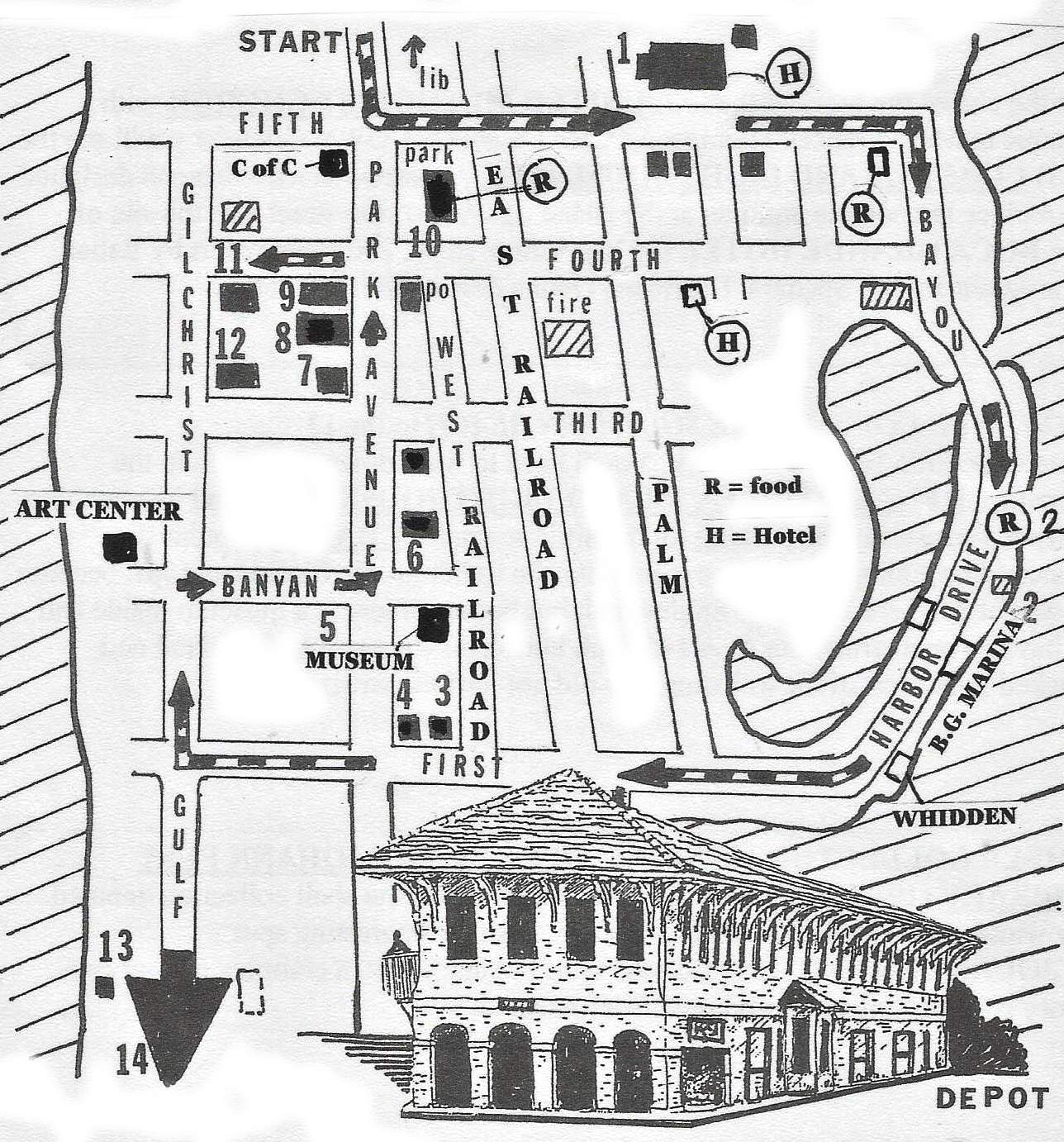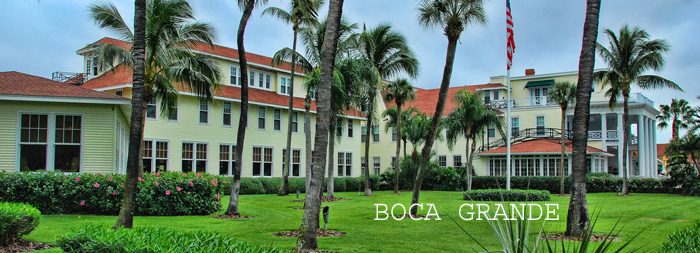HISTORIC BOCA GRANDE
(Lee County)
ISLAND FISHING VILLAGE TURNED CELEBRITY RESORT
For more information on Boca Grande - visit: BOCA GRANDE CHAMBER OF COMMERCE; ; THE BOCA BEACON; and THE BOCA GRANDE HISTORICAL SOCIETY
BOCA GRANDE, on the dual county island at the mouth of Charlotte Harbor,
is best known as America's
tarpon fishing center. Other than a small phosphate export port, Gasparilla Island was famous for its fishing plutocrats until
the construction of a private toll bridge by Robert Baynard
in 1955 and the discovery of the isolated island's charms by successful Tampa Bay
area professionals who could build expensive beach villas a few hours from
metropolis. Despite the six dollar Boca Grande Swing Bridge, Boca Grande is a great spot to visit, go to the beach by the famous lighthouse at the southern tip, and have a moderate seafood meal. The locals accept that if you can't afford to live here, you can still spend some money here.

WHERE TO START: Start in front of the island's pride, at the corner
of Fifth Street and Palm Avenue, the: (1) GASPARILLA INN (1912),
a large pale yellow frame Victorian hotel with a Classical portico and a colony
of cottages and rooms built around the golf course.
 An Arcadia phosphate executive Peter Bradley allied
with James F. Gifford, President of the Charlotte Harbor
and Northern Railroad, to build the luxury winter resort. The
hotel registraroften read like a "Who's Who", but you won't get to
read it for low key privacy is the rule here.
An Arcadia phosphate executive Peter Bradley allied
with James F. Gifford, President of the Charlotte Harbor
and Northern Railroad, to build the luxury winter resort. The
hotel registraroften read like a "Who's Who", but you won't get to
read it for low key privacy is the rule here.
DRIVE EAST ON FIFTH AVENUE along the golf course toward Boca Grande Bayou.
TURN RIGHT ON BAYOU AVENUE toward HARBOR DRIVE and the yacht basins. There's
charter boat centers and places to stop for lunch. In tarpon season there will
be fishermen from around the world. In the peak of the winter a movie star could be eating with some retired teachers. I once administered a slow pitch softball league and the Boca Grande team was filled with fishermen and millionaires with a Baptist preacher as the star pitcher. Many of them came to Punta Gorda across Charlotte Harbor in a speedboat!
CROSS
WEST AVENUE
past the (3)
COMMUNITY HOUSE and the (4) COMMUNITY CENTER. PASS PARK AVENUE and TURN RIGHT ON GILCHRIST.
THEN, if your car fits, TURN RIGHT ONTO (5) BANYAN STREET, an
amazing gnarl of shady banyan trees planted on both sides by Peter Bradley. A lot of high society people have used this spot for wedding photographs.
TURN LEFT ON PARK AVENUE. On your right is the interesting: (6) OUR LADY
OF MERCY MISSION CHAPEL, a replica of
a Spanish style mission with brick floors, and featuring a circular entrance
way. You should stop to go inside to admire the fine woodsmanship
and the real Madonna Icon of Russian design.

 COMMUNITY
CHURCH, BANYAN STREET
COMMUNITY
CHURCH, BANYAN STREET
GO TO THIRDSTREET.
On the corner to your right is the (7) BOCA GRANDE THEATER
(1924), now used as a restaurant and sometimes showplace. If you enter you'll see
an unusual open atrium, an odd theatrical design.
A few doors down is the (8) CHAMBER OF
COMMERCE. At the end of the block on your right is the POST OFFICE. On
your left is (9) FUGUTES (1916), the town's mini-everything store
founded by Jerome Fugate Sr., and visited by everyone sooner or later.
Across Fourth on the right is the famous (10)
BOCA GRANDE RAILROAD DEPOT (1910), an impressive two story structure
which now houses antique and gift stores and an ice cream parlor/restaurant.
The brick structure with the arcaded loggia was the last depot for the
Charlotte Harbor & Northern Railway. I once went into the cute ice cream parlor and saw Barbara Bush licking a cone.
TURN LEFT ON FOURTH AND LEFT ON GILCHRIST AVENUE, the route to the southern tip of Gasparilla Island. On your left is the (11) ST.
ANDREWS EPISCOPAL CHURCH, a country-style church. Go inside to view the
round stained glass window over the alter and notice
the communion rail kneelers in needlepoint.
At the end of the block is the (12) UNITED
METHODIST CHURCH with a plaque to Mary Frances Thompson. A HALF MILE
DOWN Gilchrist you'll see the (13) COAST GUARD LIGHTHOUSE (1927),
a narrow electric beacon designed to replace the notable antique. at the island tip. Across the street was the site of the
BOCA GRANDE HOTEL (1930), a three story, 200 room resort
by Italian immigrant Joseph Spadara. Hurricane Donna
destroyed it in 1960.
CONTINUE DOWN TO THE SOUTHERN BEACH to the 13 acre Gasparilla Island State Park.
You'll have to walk down the beach to the beautiful (14) GASPARILLA
ISLAND LIGHTHOUSE (1890) and its matching keeper's house. By the
parking lot is a little seaman's AMORY MEMORIAL CHAPEL
popular for waterside weddings.This is
my favorite lighthouse in Florida, not just
because it was near where I lived in Englewood,
but because there is a museum inside and it has two neat structures.A 145-mph hurricane went across the island
and sucked goods out of the gift shop window, but did not hurt the structures. WARNING:I should warn you that all over the island are very large iguanas, escaped from phosphate vessels years ago. Some people like them since they eat rats and bugs, but you don't want them visiting your patio restaurant.


SHELL COLLECTORS SPECIAL:
STOP BY THE JOHANN FUST LIBRARY
(1949) on Gasparilla on 9th Street to see the shell collection
donated by winter resident Henry Francis DuPont. Another interesting spot is JOURNEY'S
END (1914), on the Gulf at 18th
Street, a complex of four two story cottages built
of virgin pine from Arcadia.
WHERE TO EAT AND STAY: Boca Grande is not for mass consumption for the famous GASPARILLA INN, (971-964-4500) at 500 Palm, is the main resort, but visitors might want to look into the ANCHOR INN (941-964-5600) at 450 4th Street East, a 1925 two-story Vistorian with a huge veranda. There is comfort food at the RAILROAD DEPOT and downtown, but if you want seafood by the water, go to the bayside for the PINK ELEPHANT (941-964-4540), at 491 Bayou, and the EAGLE GRILLE at MILER'S DOCKSIDE (941-964-8000), at 220 Harbor Drive.



 An
An 


